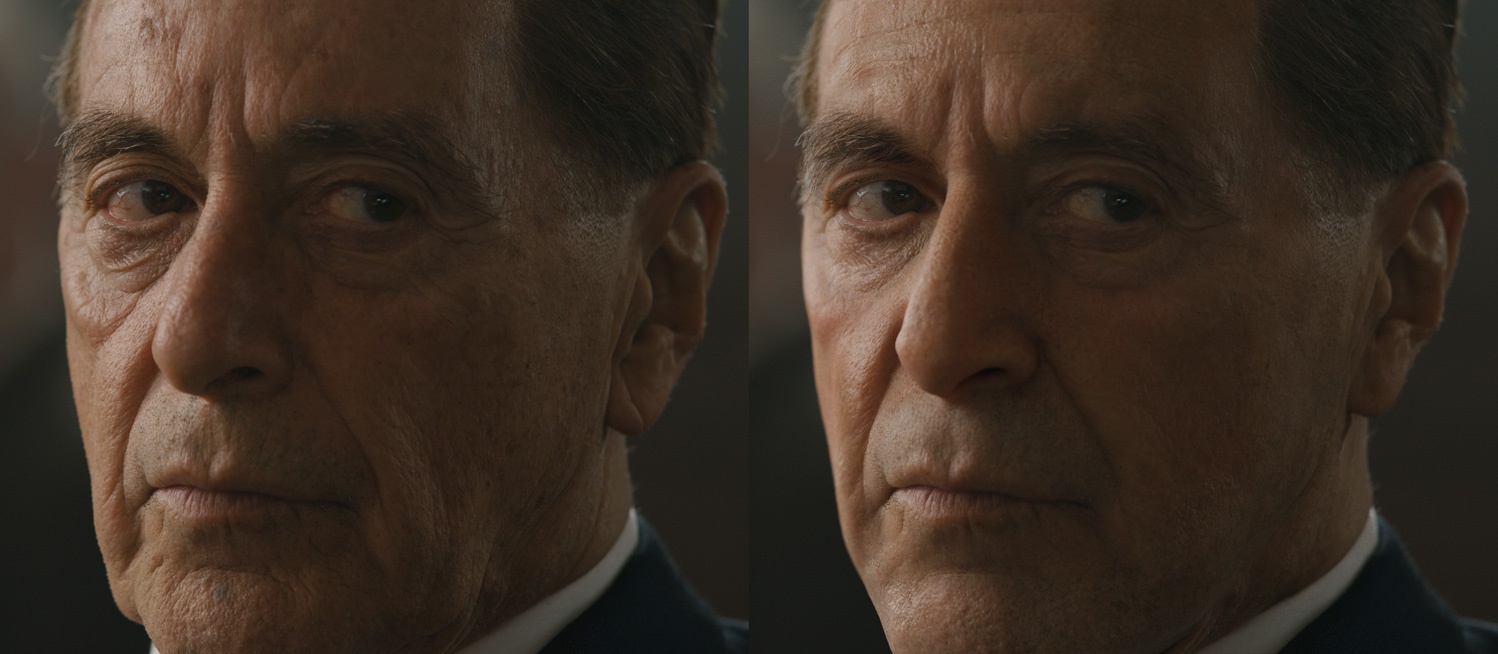Contents
Many times using a single subsurface lobe is not enough for photorealism, as exemplified in this image from The Irishman (© Netflix), where LamaSSS was combined with LamaTriColorSSS for maximum flexibility in matching the film plate.
Image courtesy of Industrial Light & Magic.
Lama Tricolor Subsurface Scattering operates differently than LamaSSS in a few significant ways. For most cases, you will be happy with the results of LamaSSS. However, there are instances where the user may want a non-physical way to control the colors of the scattering. The Color in LamaSSS uses the supplied RGB value to determine the color scatter as noted in the parameter description. This means your result may have color shifts that are not desirable. Let's say you supply a textured color of RGB 0.51 0.28 0.31 which is a pink color. The scattering result will also include the green (0.28) and blue (0.31) responses. The LamaSSS material maintains the pink color. Below is an example using this scenario illustrating the differences. Note the color shift on the Path-traced mode (Left) while the Tricolor version maintains the colors of the texture at all depths where connected.
Tricolor Parameters
The layers are specified based on their depth. The Near Layer is the topmost layer while the Far Layer is deepest.
Near Layer
The Near Layer is the top or most shallow layer.
Weight
This specifies the strength of the result and can be textured using a scalar (grayscale) signal to vary the strength or mask areas.
Color
Color is typically where textures or patterns are connected to create the resulting color or you may simply choose a single color.
Radius
When light enters a surface, it can travel for a certain distance before it stops (is absorbed or exits). This control specifies how far to travel in scene units. Larger values allow light to go further into a surface and increase the effect. This may also make objects look softer and cause some small modeled detail to be lost as the light scatters beyond those details.
Mid Layer
The Mid Layer is the next layer of depth after the Near Layer.
Weight
This specifies the strength of the result and can be textured using a scalar (grayscale) signal to vary the strength or mask areas.
Color
Color is typically where textures or patterns are connected to create the resulting color or you may simply choose a single color.
Radius
When light enters a surface, it can travel for a certain distance before it stops (is absorbed or exits). This control specifies how far to travel in scene units. Larger values allow light to go further into a surface and increase the effect. This may also make objects look softer and cause some small modeled detail to be lost as the light scatters beyond those details.
Far Layer
The Far Layer is the last layer or deepest layer.
Weight
This specifies the strength of the result and can be textured using a scalar (grayscale) signal to vary the strength or mask areas.
Color
Color is typically where textures or patterns are connected to create the resulting color or you may simply choose a single color.
Radius
When light enters a surface, it can travel for a certain distance before it stops (is absorbed or exits). This control specifies how far to travel in scene units. Larger values allow light to go further into a surface and increase the effect. This may also make objects look softer and cause some small modeled detail to be lost as the light scatters beyond those details.
Scattering Parameters
Scale
This is a simple multiplier for the above Radius effect. This is useful for a quick tweak to the results, especially if you're driving the Radius with a texture and don't want to repaint. It's also useful when transferring a shaded asset between scenes with different scales.
Follow Topology
This considers the surface normals (shape and implied details) while calculating the scattering. This may help preserve lost details.
Subset
Setting a value here can control what objects may contribute to one another indirectly as light may go from one surface to another. Sometimes an object creates halos or darkening when they interpenetrate one another and this control specifies what does and does not contribute based on their value.
Continuation Rays
Sometimes you may have objects embedded in one another, like bones or teeth. If these cause artifacts or something undesirable, setting this to "on" will ignore internal objects.

